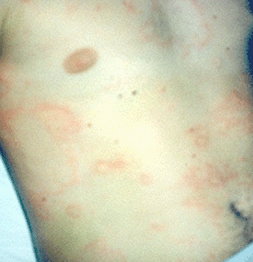- What is Hypersensitivity reaction – Type III
- Statistics on Hypersensitivity reaction – Type III
- Risk Factors for Hypersensitivity reaction – Type III
- Progression of Hypersensitivity reaction – Type III
- Symptoms of Hypersensitivity reaction – Type III
- Clinical Examination of Hypersensitivity reaction – Type III
- How is Hypersensitivity reaction – Type III Diagnosed?
- Prognosis of Hypersensitivity reaction – Type III
- How is Hypersensitivity reaction – Type III Treated?
- Hypersensitivity reaction – Type III References
What is Hypersensitivity reaction – Type III
Hypersensitivity means that the body responds to a particular substance (called allergens) in an exaggerated fashion, where it does not happen in normal circumstances. There are 4 types of hypersensitivity reaction, type I, II, III and IV. They are different in terms of the disease manifestation and pathological processes. However, only type III hypersensitivity reaction will be discussed here.
In type III hypersensitivity, soluble antibodies bind to antigens to form immune complexes in the blood. These complexes travel through the blood stream and get deposited in various organs. Hence this can occur in many parts of the body. Generally, common sites of deposition include:
- skin
- kidney
- joints
- blood vessels
- lungs
One example of a Type III hypersensitivity is serum sickness, a condition that may develop when a patient is injected with a large amount of antitoxin that was produced in an animal. The image below is that of serum sickness:

Statistics on Hypersensitivity reaction – Type III
The cases of different diseases vary widely. Certain diseases can be common, such as rheumatoid arthritis. Diseases such as systemic lupus erythematosus can have the figure of 1.8-7.6 cases per 100,000 per year.
Note that systemic lupus erythromatosus is a disease of mixed hypersensitivity – type II and III hypersensitivity reaction occur in this disease.
Risk Factors for Hypersensitivity reaction – Type III
Depending on the manifestations of different type III hypersensitivity diseases, there are different risk factors as well.
There are some gender differences between diseases of type II hypersensitivity. Some diseases are more common in women such as rheumatoid arthritis.
As different diseases are included in type III hypersensitivity, ethnicity and geographical location can have impact on the disease cases.
Progression of Hypersensitivity reaction – Type III
Type III hypersensitivity reaction is induced by antigen-antibody complexes. By the various biochemical mechanisms, the end result are tissue damage to the body.
The antigens can either be from the body itself or from outside the body (for example, bacteria or microorganisms that infect the body).
It must be remembered that the formation of antigen-antibody complex in the circulation does not indicate the presence of type III hypersensitivity diseases. It is the capability of these complexes to mount a reaction leading to tissue damage that is the cause of diseases themselves.
How is Hypersensitivity reaction – Type III Diagnosed?
Depending on the different type of diseases, some general investigations may be necessary. Basic routine investigations may include looking at the blood function, liver function, thyroid function and kidney function.
Prognosis of Hypersensitivity reaction – Type III
Type III hypersensitivity diseases can be self-limited or long-standing depending on different disease patterns. Condition such as systemic lupus erythomatus (SLE) can have very poor prognosis if kidney involvement is severe.
How is Hypersensitivity reaction – Type III Treated?
There is no cure for these diseases, the treatment aims at symptom control only. Because of the pathogenesis of these diseases are antibody in origin, a lot of treatment options are aimed at that.
Depending on the severity of the hypersensitivity reaction, different treatment approaches are applied. Treatment options, either given alone or in combination, include the following:
- steroids: these drugs include prednisolone, dexamethasone, etc. In type II hypersensitivity diseases, sometimes high dose steroids are used. Depending on the diseases, steroid could become a long-term medication. In such cases, long term use will need medical supervision for monitoring of potential side effects.
There are other treatment methods all aiming at altering the body’s immuune response, this include:
- other drugs: interferon, cyclophosphamide, cyclosporin
- many of these drugs are still on research at the moment.
Hypersensitivity reaction – Type III References
- Braunwald E et al. Harrison’s principles of internal medicine. 15th ed. New York; McGraw-Hill; 2001.
- Cotran, Kumar, Collins. Robbins Pathologic Basis of Disease. 6th ed. WB Saunders Company. New York. 1999.
- Davidson A, Diamond B: Autoimmune diseases. N Engl J Med 2001 Aug 2; 345(5): 340-50.
- Middleton E Jr, Reed CE, Ellis EF, et al, eds: Allergy: Principles and Practice. 5th ed. St. Louis, Mo: Mosby-Year Book; 1998.
- Roitt IM: Essential Immunology. 9th ed. Oxford, UK; Blackwell Scientific; 1998.
- The Merck Manual: Disorders with Type III Hypersensitivity Reactions [online]. 2005. [Cited 2005 October 9th]. Available from: http://www.merck.com/mrkshared/mmanual/section12/chapter148/148b.jsp
- Up to Date: Clinical features of rheumatoid arthritis [online]. 2005. [Cited 2005 October 9th]. Available from: http://www.utdol.com/application/topic.asp?file=rheumart/3022&type=A&selectedTitle=1~209
All content and media on the HealthEngine Blog is created and published online for informational purposes only. It is not intended to be a substitute for professional medical advice and should not be relied on as health or personal advice. Always seek the guidance of your doctor or other qualified health professional with any questions you may have regarding your health or a medical condition. Never disregard the advice of a medical professional, or delay in seeking it because of something you have read on this Website. If you think you may have a medical emergency, call your doctor, go to the nearest hospital emergency department, or call the emergency services immediately.







